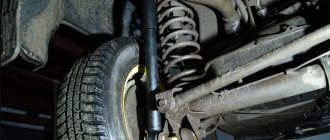Many drivers will have their own opinion on this matter. Some will be guided by legal requirements, namely the minimum tread depth. Others will say that tires should not be used for more than five years, after which the rubber loses its properties and becomes “wooden.” Still others will remember that they read about mileage restrictions, ranging from 40 to 60 thousand kilometers. Still others will operate only with the amount of money in their wallet.
There is, of course, a very desperate group of motorists. These guys ride until the last minute and wear down those meaty tires into racing slicks. Well, individual adherents can be seen rustling spikes on the asphalt in mid-July.
How do you like the rear tires of this Mitsubishi Galant?
Whose approach is correct? There is no clear answer, except that the latter pose a serious danger both to themselves and to other road users. Almost all the remaining methods have a certain logic behind them.
Tread depth
Driving a car whose tires have a residual tread depth less than the required values is punishable by a fine. Police rarely pay attention to this, but it is worth bearing in mind the administrative responsibility. Thus, according to Part 5 of Article 590 of the Code of Administrative Offenses of the Republic of Kazakhstan, the treasury will have to pay 5 MCI, or 13,890 tenge in 2020. Repeated violation within a year increases the penalty to 20 MCI (55,560 tenge).
The minimum remaining tread depth is specified in paragraphs 5.6.1 and 5.6.2 of Appendix No. 7 TR CU 018/2011 “On the safety of wheeled vehicles”. The text states that for passenger cars the residual must be at least 1.6 mm for summer tires and at least 4 mm for winter tires and those marked with the signs: M+S, M&S and M S.
Note that measuring the tread depth with a ruler is an extreme step. Almost all modern tires have special wear indicators. As soon as they appear, the tires should be replaced.
How to extend the life of car tires
Tires cannot be considered a perishable product, delicate and needing to be stored away from roads and cars. These are durable, resistant and high-tech products designed to withstand many hardships of road service. And there is only one condition for them to fully utilize their considerable resource - to follow the operating rules.
Some of them are outlined above, the rest are taught in driving schools. There are no secret techniques or nuances here. Pressure, speed, temperature, rough driving on bad roads - the effect of such driving on tires is known to everyone. We can only add the provision of seasonal storage conditions.
Changing summer tires to winter tires and vice versa has become mandatory. If there is no confidence and conditions that you can independently ensure the above requirements for storing tires, then it is better to use the services of emerging warehouse organizations, where, for a small fee, seasonal tires will wait their turn in compliance with all scientific and technical rules.
Tire age
The average service life of almost all tires from major manufacturers is 7–10 years, depending on their seasonality. True, such a duration should be counted on if a number of operational requirements are met. These include driving on high-quality roads with optimal tire pressure, correctly set wheel alignment angles and a properly functioning suspension.
The age of a tire can be determined by a special marker. Four numbers enclosed in an oval (more often found on the inner sidewall) are DOT markings, simply the production date. The first two digits indicate the week, and the last two indicate the year of production.
Any of the above parameters can significantly reduce the service life of rubber. For example, if the pressure in the wheel is insufficient, the side parts of the tread will wear off faster, and if the pressure is high, the middle part will wear off. Irregularities in geometry lead to uneven tire wear.
The middle part of the tread is more worn. The cause may be excess pressure in the wheel.
How and where tires are stored is also an important factor. Manufacturers recommend a dry, cool and dark room.
In Kazakhstan, you should not count on more than five years of operation. However, you can actually drive on one set of wheels for about ten years. Whether it's worth doing is a completely different question. From personal (almost) experience: tires produced in one of the CIS countries lasted from mid-2008 to spring 2018. The car's annual mileage was small, about 10 thousand km per year, which included forays into light off-road conditions. The remaining tread after all this time would have allowed the vehicle to travel the same distance, but when one of the tires was removed for repair (the wheel was regularly flat), the landing board literally crumbled.
How long can tires be stored without use?
When storing tires, even perfectly correctly, they cannot get any younger. Contact with atmospheric oxygen, slow reactions in rubber, plastic and metal, occurs constantly, so storage is included in the guaranteed shelf life.
Buying a tire that has been stored for these five years is too optimistic. Although even at the end of the term the wheel will remain completely safe and meet the manufacturer’s requirements.
But technically, within a year the tire will be theoretically unsuitable. And here a lot depends on information that cannot be accessed.
No one will say how the tires were stored, how carefully all recommendations were followed. Especially if it's winter tires. You definitely can’t buy it after long storage.
Mileage
Another guideline for changing tires is mileage. You can often find recommendations on the Internet that refer to GOST. Their text reads: for passenger cars with a carrying capacity of up to two tons, the tire service life is 45,000 kilometers.
You can also find references to the operational mileage standards for vehicle tires approved by the Ministry of Transport of the Russian Federation. Their average service life varies from 40 thousand kilometers for Russian tires to 60 thousand for foreign ones. Please note that this document lost force after the entry into force of the Technical Regulations of the Customs Union.
You can also determine how long a tire can run using the Treadwear (TW) parameter, which indicates the tire wear resistance index. It is not often paid attention to. This figure is usually of interest to those who plan to use the car in a sports environment. Soft and, accordingly, grippy rubber has a fairly low TW, which is what racers focus on.
Surely you have a reasonable question about how the wear resistance index relates to mileage. TW appeared thanks to specialists from the National Highway Traffic Safety Administration (NHTSA). To calculate it, the tire at the test site is compared with a special sample, the TW of which is already known.
According to the methodology, TW100 is equivalent to 48 thousand kilometers until the rubber is completely worn out, that is, Nokian Hakka Green, for example, having TW400, can last up to 192 thousand kilometers. True, in the real world, wear is influenced by many factors that we discussed above, as well as driving style. Therefore, it is recommended to divide the calculation results for TW by two. It turns out 96 thousand, or almost 5 years of operation, provided that in the warm season the car travels about 20 thousand kilometers.
Incorrect tire pressure can significantly reduce tire life. Don't forget to check it
In total, we have three parameters that should help you understand how long tires will last if used correctly, and also tell you when to send a set of tires for scrap and bother buying new ones. This can be done on the Kolesa.kz portal using the search form in the “Spare parts” section.
When tires should not be used
Tire condition is an essential safety element. Therefore, they must definitely be replaced with new ones if:
- the tread depth does not comply with the regulations, it is different for all types of tires;
- the expiration date has been significantly exceeded, the tire is more than 10 years old;
- there are deep cuts, the cord or breaker is damaged;
- the tire was subject to uneven wear;
- the rubber began to crack due to age and harsh use;
- the tire does not hold pressure even on a new rim;
- the wheel is poorly balanced.
A specialist can determine the condition of the tire more accurately. Experienced tire service employees have a lot of practical information.
Tire marking
This is complete information about tires in one place. It is standard; dimensions, technological characteristics, and features are indicated on the side.
What to look for when purchasing
When purchasing, you need to look at the following characteristics:
Is the type and size suitable for a particular car? These specs look like 195/65R15, where:
- 195 – profile width in millimeters;
- 65 – percentage ratio of profile height and width;
- R – radial cord;
- 15 – disk diameter in inches.
You can learn about the needs of a specific machine from technical documents.
- Speed and load. For example, 98W means: 98 – load per wheel (kg). W – maximum speed (km/h). Decodings are indicated in special tables common to the whole world.
- Brand, date of manufacture. After the manufacturer's letter designation there are four numbers - this is the week and year of manufacture.
- Seasonality. The summer one is marked with the image of the sun, the winter one – with snowflakes.
How to identify expired tires
You need to find the production date and add 5 years to it. You also need to stock up on measuring instruments and assess the degree of tread wear. The residual height of 2-3 mm will be critical for summer, and 4-6 mm for winter.
Standards and recommendations of tire manufacturers
Measuring the depth of the tread layer.
Tires not only wear out during vehicle operation, they are also subject to natural aging. These products must be replaced if their service life is exceeded. The fact is that tires are made from a rubber compound, which ages over time and loses its elasticity and resilience. The use of such tires is unsafe: the car may become uncontrollable, plus the tire may rupture while driving.
According to domestic standards, the service life of tires is 5 years from the date of their manufacture; these standards are regulated by GOST 4754-97 and 5513-97. In Western countries, the service life of tires reaches 10 years. Legislatively, neither in Russia nor in the West there are acts obliging motorists to replace tires after the end of their warranty period. But for the sake of your own safety and driving comfort, such products should be replaced.
Manufacturers indicate the shelf life of tires, it is 3 years; according to the recommendations of the manufacturers, tires that have been stored for more than this period cannot be considered new. If the rules for storing tires are not followed, they are destroyed, the tire begins to crack, may dry out, lose elasticity, and so on. Its use is unsafe, even if the tire is less than 3 years old.
You can find out how old a tire is by looking at the corresponding marking on its side.
We recommend watching a video about the signs indicating the end of the service life of tires:











